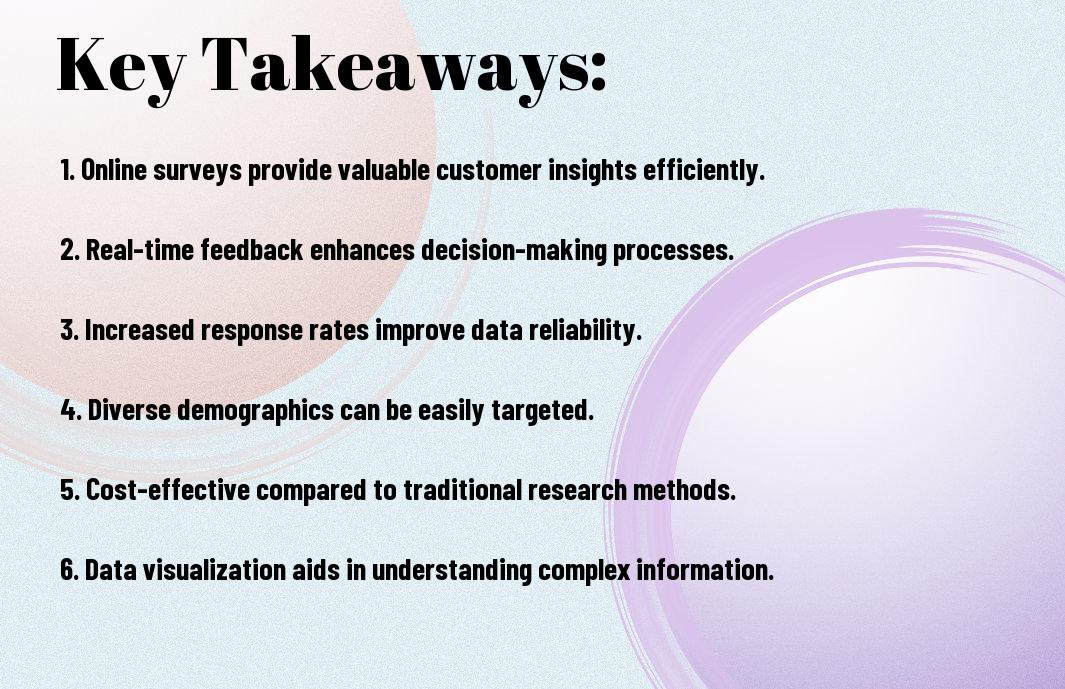Over the past decade, online surveys have transformed the landscape of market research, enabling you to gather valuable insights quickly and efficiently. By leveraging digital tools, you can easily reach your target audience, obtain reliable data, and drive informed decision-making. This blog post will explore how online surveys can enhance your understanding of consumer preferences and behaviors, allowing you to adapt your strategies to meet market demands effectively. Dive in to discover the imperative role of online surveys in empowering your business decisions.

The Importance of Market Research
While you may have brilliant ideas for your products or services, market research serves as the backbone for making informed decisions. By leveraging market insights, you can align your business strategies with consumer needs and market dynamics, ultimately leading to more successful outcomes. Understanding the market landscape helps you mitigate risks and ensures that your offerings resonate with your target audience.
Understanding Consumer Needs
About understanding your consumers is necessary for tailoring your products and services effectively. By conducting market research, you gain insights into preferences, pain points, and purchasing behaviors, allowing you to create solutions that directly speak to your audience's desires.
Identifying Market Trends
Among the many benefits of market research, identifying market trends enables you to stay ahead of the competition. By recognizing emerging patterns and shifts in consumer behavior, you can adapt your strategies to meet demand and seize new opportunities.
Also, staying updated on market trends is key to making proactive decisions that position your business for future success. Utilizing online surveys allows you to gather real-time data on consumer sentiments, enabling you to forecast trends and adapt your approach as necessary. This agility not only keeps you relevant but also empowers you to innovate around your audience's evolving needs.

The Evolution of Online Surveys
One of the most significant advancements in market research, online surveys have transformed how you gather consumer insights. The rise of the internet has allowed surveys to reach wider audiences more efficiently and cost-effectively. You can explore the benefits of these surveys in more detail in this article on Why Conduct Online Market Research Surveys?.
Historical Context
At the onset of market research, surveys were predominantly conducted via mail or face-to-face interactions. This process was time-consuming and often limited by geographical constraints, reducing the scope and accuracy of data collection. You may find that, as consumer behavior evolved, researchers sought more efficient methods to engage with their target audiences.
Technological Advancements
Historical developments in technology have played a vital role in the transformation of online surveys. The advent of the internet not only expedited data collection but also allowed for sophisticated survey designs and analytics tools. With the integration of mobile devices and social media, you can now reach respondents instantly, enhancing the quantity and quality of the data you gather.
It is fascinating to see how tools like automated survey platforms and real-time analytics have revolutionized your ability to interpret audience responses. As survey techniques evolved, you can now personalize your questionnaires, target specific demographics, and analyze results almost instantaneously. These advancements enable you to make informed decisions based on real-time data, ensuring your business strategies align with your audience's preferences and behaviors.
Designing Effective Online Surveys
Keep in mind that designing effective online surveys is vital to gathering insightful data. Your questions should be clear, concise, and focused on the goals of your research. For more insights, check out From Data to Decision-Making: How Online Surveys Offer a ....
Question Types and Formats
On your survey, utilizing various question types and formats can significantly enhance the quality of responses. Consider the following options:
| Question Type | Description |
| Multiple Choice | Let respondents choose one or more options. |
| Rating Scale | Measure attitudes with a scale (e.g., 1 to 5). |
| Open-Ended | Allow detailed responses for qualitative insights. |
| Dichotomous | Simple yes/no questions for straightforward answers. |
The right mix of formats will lead to richer data and more valuable insights.
Best Practices for Engagement
Along your survey design journey, consider how to maximize participant engagement. Engaging surveys boost response rates and the quality of data collected.
Engagement is key; ensure that your surveys are not only informative but also enjoyable to complete. Use clear language and simple layouts to maintain interest, and ensure your surveys are mobile-friendly. Personalize questions when possible, and consider offering incentives to participants. By implementing these practices, you will create an inviting atmosphere that encourages thoughtful responses, ultimately providing richer insights for your research objectives.
Analyzing Survey Data
To effectively analyze survey data, you need to synthesize the information collected into actionable insights. This involves organizing the data for easier interpretation, identifying trends, and understanding the implications of different responses. Through meticulous analysis, you can uncover valuable patterns that will guide your decision-making process and enhance your market strategies.
Data Interpretation Techniques
Around the interpretation of your survey data, you can use various techniques to draw substantive conclusions. Techniques such as cross-tabulation, thematic analysis, and sentiment analysis allow you to decode complex information in a manner that aligns with your research objectives. This process transforms raw data into meaningful insights, helping you make well-informed decisions.
Utilizing Statistical Tools
Data analysis can be significantly enhanced by utilizing statistical tools tailored to your survey type and goals. These tools can help you measure relationships, test hypotheses, and ensure the reliability of your findings.
At your disposal are various statistical tools such as SPSS, R, and Excel, which can perform advanced operations like regressions, ANOVA, and descriptive statistics. By implementing these tools, you can examine correlations, assess the strength of relationships, and validate the significance of your survey results. This statistical approach not only reinforces the credibility of your insights but also equips you with a robust framework for making data-driven decisions in your market research efforts.
Case Studies: Successful Applications of Online Surveys
After exploring the landscape of online surveys, it’s evident that many organizations leverage this tool effectively to derive actionable insights. Here are some notable case studies:
- A tech firm utilized online surveys to gather feedback from 5,000 users, leading to a 30% increase in product satisfaction scores.
- A retail company conducted a survey with 2,000 participants, which resulted in a strategic shift that boosted sales by 25% in six months.
- A non-profit organization engaged 1,500 respondents to assess community needs, enabling them to allocate resources efficiently and improve outreach by 40%.
- A healthcare service provider implemented online surveys for 8,000 patients, resulting in improved patient satisfaction ratings by 35%.
Industry-Specific Examples
Case studies can highlight the versatility of online surveys across various sectors. In the hospitality industry, a hotel chain utilized survey data from 3,000 guests to enhance service quality, leading to a remarkable 50% increase in repeat bookings. Meanwhile, a consumer goods company that surveyed 4,000 customers was able to identify market preferences, allowing for new product launches that captured a 20% market share within a year.
Key Takeaways from Real-World Data
Against the backdrop of these case studies, it's clear that online surveys reveal valuable patterns that influence decision-making. The quantifiable data derived from surveys can pinpoint specific areas for improvement, identify customer needs, and guide your strategies effectively.
Online surveys serve as a powerful tool that helps you gather significant insights directly from your target audience, which can drive your business strategy. The data you collect can lead to impactful changes, whether it’s refining products or enhancing customer service. By understanding what resonates with your customers, you can align your operations to meet their expectations, ultimately fostering loyalty and achieving your growth objectives.
Future Trends in Online Surveys
Not only are online surveys becoming more prevalent, but they are also evolving to adapt to the changing landscape of consumer behavior and technology. As you engage with your audience more effectively, you can expect innovations that enhance personalization, mobile accessibility, and integration with social media platforms. These advancements will provide you with richer insights while streamlining your survey processes.
Innovations on the Horizon
To stay ahead in market research, you should look out for emerging technologies that will transform your approach to online surveys. Anticipate features such as dynamic question flows, real-time data analysis, and broader integration with other tools that will amplify your ability to gather meaningful feedback. These innovations will ultimately help you make better-informed decisions for your business.
The Role of Artificial Intelligence
Innovations in artificial intelligence promise to reshape how you conduct online surveys and analyze the data you collect. AI can enhance your surveys through improved targeting, predictive analytics, and automated data synthesis, allowing you to extract deeper insights from responses.
Online surveys powered by AI will enable you to analyze large volumes of data quickly and efficiently. These tools can identify patterns and trends that may not be obvious at first glance, allowing you to make decisions based on comprehensive insights. Additionally, AI-driven chatbots can facilitate conversational surveys, creating more engaging experiences for your respondents. By embracing these technologies, you can further optimize how you gather and interpret data, making your market research efforts more effective than ever.
Conclusion
To wrap up, recognizing the crucial role of online surveys in market research empowers you to make informed decisions based on valuable insights. By leveraging these tools, you can effectively gather data that shapes your strategies and drives growth. For more information on how you can transform data into decisions, check out From data to decisions: Powerful market insights begin ....
Q: Why are online surveys effective tools for market research?
A: Online surveys provide a cost-effective and efficient way to gather data from a wide audience. They allow researchers to quickly reach a large number of respondents, often in real-time. Additionally, online surveys can be easily customized and distributed across various platforms, making it simpler to target specific demographics. The data collected can be analyzed quickly, providing insights that can inform business strategies and product development.
Q: How can businesses ensure they design effective online surveys?
A: To design effective online surveys, businesses should focus on clear and concise questions that avoid ambiguity. Using a mix of question types, such as multiple choice, open-ended, and rating scales, can enhance engagement and yield richer data. Pre-testing the survey with a small audience can help identify any confusing elements and improve the overall survey experience. Additionally, keeping surveys short and to the point will likely result in higher completion rates.
Q: What are some common challenges faced when conducting online surveys, and how can they be addressed?
A: Common challenges include low response rates, biased results, and data quality concerns. To address low response rates, businesses can incentivize participation or ensure the survey is easily accessible on various devices. To minimize bias, it’s important to carefully define the target audience and use random sampling techniques when possible. Additionally, implementing validation tools during the survey can help ensure high data quality, allowing for more reliable analysis and insights.